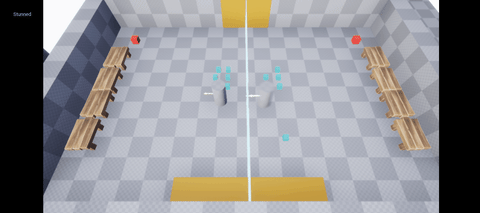Hello everyone,
We are a group of students behind a beginning game, so far, called Tension. The only restriction we've gotten, was that the game must be in a multiplayer perspective, more specifically, in the party co-op genre. After a brainstorming session we've gotten a small idea in mind of what we wanted to achieve. The core mechanic is that 2 players are connected with some form of rubber while a forcefield splits the playfield in half, with each player occupying a part of the field. The players have to work together to disarm a bomb, as only one has access to the bomb and the other to the tools. The rubber however, only has a certain length, but, this can be extended with a little bit of stretching, though beware of the setback, so u don't smack your partner with his or her face to the forcefield and knock them out!
As you can see, the idea is simple, but has a lot of potential to grow in a fun and wacky looking game, as we're used from party co-ops. With feedback and explaining it to our mentors, that supported the idea, we were asked to ask ourselves some questions regarding our prototyping and production pipelines. Since our group is a fair mixture of artists and developers alike, we could ask our self a broad variety of things.
The first thing we asked ourselves was which game engine we would choose, since we had the choice of Unity and Unreal Engine 4. All of us were somewhat familiar with UE4 but only a few had experience with Unity. As a team we helped and supported each other and gave brief crash courses where necessary, and believe me, they were... However, we did ended up in choosing UE4 over Unity, because for several reasons. As mentioned before, since all of us had somewhat experience in it, and learning Unity on such a short notice would probably not be such a good idea. Second to that, was our graphic style, we all agreed we’d wanted to go 3D instead of 2D and Unreal has an easier job to implement this. Thirdly is the fact of blueprinting, not every artist in our group has the knowledge to code in C++ and as a team we don’t want to leave everything for one group of people, or leave someone behind, we try to help out where and how we can. The blueprinting system is easier to understand for every one of us, we might not all be coders, but we could still have input that way.
The second question we asked ourselves was if it would not be beneficiary to model in Maya instead of 3DS Max, since the industry is evolving in favour of the first while the latter starts to move more to the background. Plus we also know certain teachers want to go in the same direction, so we could see ourselves as the guinea pigs of all the groups. Since one of our group members has fairly good knowledge of Maya, she gave it a try as first one and her experience was surprisingly positive, with the basic bomb she modeled.
The best thing was that you could just import the same shortcuts we use in 3DS Max to Maya and it was all very intuitive as everything tends to stick together in the same menus, whereas with Max it can be hidden behind several. The annoyance however, was that not everything available in Max was present in Maya, and visa versa and Max and Maya use different workspaces, so she had to find workarounds (swiftloops for example), which cost her precious time. To conclude this we decided to stick with Max for now, even with the many pro’s of Maya, simply for the benefit of our time schedule.
Our third question was more mechanic related, we asked ourselves how we would be able to implement the physics of the rubber connecting our players. Our coders were incredibly intrigued with this and started to work on this straight away. After a few days and during lunchbreak coding sessions, they could show the group something that worked fantastically. They were able to implement the restrictions to the players so they could not move outside a certain radius of each other, while also letting them bumb into the forcefield they provided in the blockout. Though this was still very simple and basic, it showed us how to work towards what we had in mind.

The last question we asked was what kind of art style we wanted to go for. We already made the choice for going 3D instead of 2D, but that was still very vague. Will we go PBR, hand painted, cartoony, realistic, etc… With the artist we discussed which was more possible with the theme we had in mind, while also asking the opinions of our devs. We asked them to show us some mood boards what we liked, our artists could work around those ideas. Eventually we chose to go for a heavy stylised and cartoony feeling with bright and saturated colours, but where everything still remains very distinctive. With little bodies and big heads, detached hands and little or no legs at all.
All these questions gave us a lot to work around on a week, in which we have to meet up with our mentors and try to persuade them to our views and ideas while also listening to the feedback and criticism they provide.
I hope this dev log shows a little of our starting point and the direction we’re going with our small project. For now we have to finish up our prototyping phase to conclude where our struggles will be and what we have to do better. We hope we gave you some insight in Tension and do hope, those willing, to give us feedback or ask us questions.
Kind regards,
Matthias, production manager


